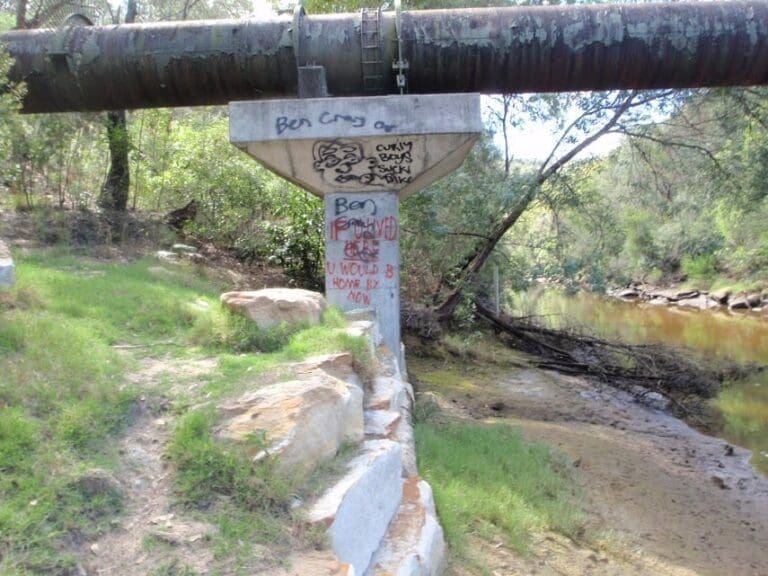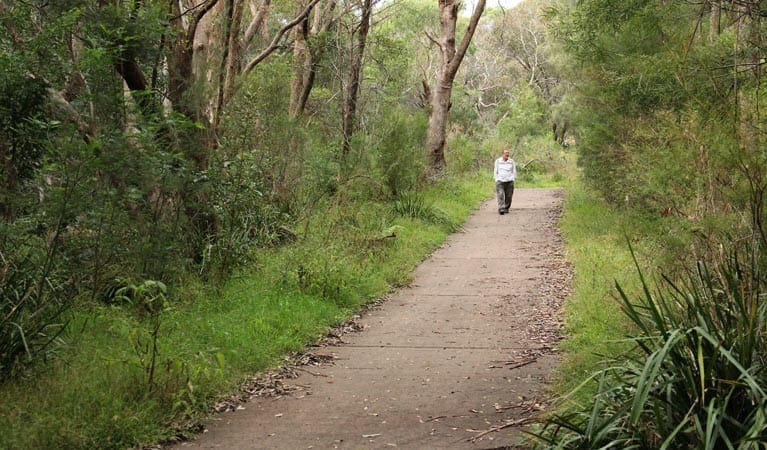Hike at a Glance
Max elevation: 603m
Min elevation: -61m
Total Ascent: 8451m
Hike overview
The Great North Walk is a walking track which runs from Sydney to Newcastle in New South Wales, Australia. The main track, 250 kilometres in length, runs between the Obelisk in Macquarie Place in Sydney to Queens Wharf Tower in Bicentennial Park in Newcastle and is well sign-posted. There are many "side tracks" which link the track to populated areas along the length of the walk. The walk includes a huge variety of wildlife and scenery.
A 25-kilometre section at the northern, Newcastle end, is also known as the Yuelarbah Track. This section runs from the Teralba railway station to the Queens Wharf on Newcastle Harbour. At Kahibah Station, the Great North Walk uses a short section of The Fernleigh Track and passes along the northern side of Glenrock Lagoon to get to the coast.
After its official start in Macquarie Place, the walk continues through the suburb of Hunters Hill, where there are many heritage homes, then arrives at the Lane Cove River. It follows the river through the Lane Cove National Park to Thornleigh, then follows Berowra Creek. Further north, the track crosses over to the Ku-ring-gai Chase National Park before proceeding to Brooklyn, on the Hawkesbury River. The river can be crossed either by train or boat, after which the track proceeds north through Brisbane Water National Park and the Ourimbah Valley before reaching the Watagan State Forest. Further north, the track veers east in the vicinity of Brunkerville and follows the Myall Range for some distance before reaching Teralba, on the southern fringes of Newcastle. It then proceeds to its official finishing point in Newcastle.
In addition to the main track between Sydney and Newcastle, there is an extension that goes north to the Hunter Region. The extension departs from the main track in the vicinity of Brunkerville, and proceeds along a country road to the village of Paxton, passing abandoned coal mines along the way. From Paxton it proceeds north and follows the Mount View Range, where there are extensive views in the direction of Cessnock. The track then descends the northern end of the range before terminating in the wine-making area of Pokolbin.
The total walk from Sydney to Newcastle takes between 8 and 14 days to complete, with popular camp sites at designated spots along the way. Many of these sites are on ridge tops with no available water supply. Where natural standing water is available, it is not necessarily safe to drink and should be treated before use.
Tips
- It is not necessary to do the walk in one go; individual sections can be completed easily as day walks.
- The track is often close to the railway line, providing convenient rail access at a number of points.
- Some early sections in Sydney are through local suburbs on sealed roads.
- There are more than a dozen ancient Aboriginal rock art sites along the route.
- The best time to take this walk is late autumn, winter and spring. Summer is extremely hot and should be avoided, particularly if bushfire risk is high.
For more information visit The Great North Walk website
Gallery
Got some great shots from this hike? Upload your photos here to inspire others and show off the beauty of the trail!
Click to view form >>
Submitting your photos doesn’t mean you lose ownership. You can be credited for your contributions, and you can request removal at any time.
Content use
Please don’t copy GPX files or content from this site to AllTrails or other platforms. Each trail has been personally mapped, documented, and refined to support Australia’s bushwalking and hiking community. While some details come from land managers, every listing reflects significant personal effort. This is a free, community-driven initiative—your respect helps keep it that way.
Walk map and GPX file
Max elevation: 603 m
Min elevation: -61 m
Total climbing: 8451 m
Total descent: -8445 m
Getting there
Getting to the trailhead: Macquarie Place Park.
Good access exists to both ends of the track with regular public transport to Sydney and Newcastle.
Closest towns to this walk: Darling Harbour, Millers Point, Pyrmont, Sydney, Ultimo
Similar walks nearby
Looking for more walks in or near Macquarie Place Park? Try these trails with a similar difficulty grade.
Track grade
Grade 5 (Difficult) - Walks for the Most Experienced: Grade 5 represents the most challenging walking tracks on the AWTGS. These are only recommended for very experienced and fit walkers with specialised skills, including navigation and emergency first aid. Tracks are likely to be very rough, very steep, and unmarked. Walks may be more than 20 kilometers. These challenging walks demand a high level of fitness and experience to navigate difficult terrain, significant elevation changes, and potentially unformed paths.
Explore safe
Plan ahead and hike safely! Carry enough water, pack layers for changing conditions, and bring safety gear like a torch, PLB, and reliable communication device. Check official sources for trail updates, closures, and access requirements, and review local weather and bushfire advice. Most importantly, share your plans with someone before you go. Being prepared makes for a safer and more enjoyable hike! Stay Safe, Explore More, and Always #ExploreSafe.
Packing checklists
What you carry in your pack depends on factors like weather, terrain, and your adventure type. Not sure what to bring? My free planning, food, and packing checklists are a great starting point, covering day hikes, overnight trips, and multi-day adventures. Use them to customise your kit and always prioritise safety.
Let someone know
Before heading out, take a moment to fill out your trip intentions form. It’s a quick way to share your hike details with family or friends. If something goes wrong, they can notify emergency services, ensuring a faster response and peace of mind. Stay safe and enjoy your adventure
Suggest an edit
Spotted a change on this trail? Maybe there are new features, the route has shifted, or the trail is permanently closed. Whatever the update, I’d love your input. Your feedback helps fellow hikers stay informed and ensures that our trail info stays fresh and reliable.
Acknowledgement of Country
Trail Hiking Australia acknowledges the Traditional Owners of the lands on which we hike and pay respects to their Elders, past and present, and we acknowledge the First Nations people of other communities who may be here today.







8 Reviews on “The Great North Walk (250km)”
Kelly Campbell
Kerry Tober
planning on doing the whole thru hike march next year once it cools down, anyone wishing to get a group hike going?
Let’s do it in 8!
No
ohhh yes would love to do this Melinda Ritchie ??
Ohhhhhh yeah! ? stace would scratch my eyes out…
Ooh we need to do a bit of this together M!
Peter Fisher yes let’s leave it at least another 5 years
Philip Vincent why not?
Shaye Meaghan Scotney after oxfam, goals ?
Sophie Woodworth Sammy Hunt. You two up for this ??
Stacey Stone too soon?
Sue I live at Westleigh near GNW. I trail run – walk it solo. PM me if you are keen for a walk partner.
Tanya Marshall-Disher….
Teyanah Brown
We have been doing it for years with our kids – we have walked from Sydney central to Hornsby – it’s amazing and a great way to discover Sydney even if you are a Sydneysider like me!!
Yes – let’s book it in – love that
Yes and u will have at least a 12 year old boy and 15 year old girl going with you both 🙂 Fun time
Yes there are some lovely walks, and you can choose how much you do. Put it on the list!